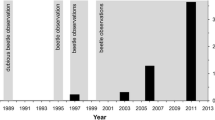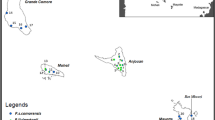Abstract
Melipona capixaba, popularly known as “uruçu preta”, is a stingless bee restricted to the mountainous Atlantic Rainforest areas of Espírito Santo State, Brazil. Due to the endemism and small population size, this species discovered in 1994 is now considered “vulnerable to extinction”. Using ISSR, PCR–RFLP and microsatellites markers, we studied the genetic variability and structure of M. capixaba from 88 colonies collected throughout the distribution area of the species within Espírito Santo State. The microsatellite, ISSR and mitochondrial haplotype analyses showed that M. capixaba has low genetic variability compared to other insect species. The molecular analyses also indicated a high genetic similarity among the M. capixaba samples, with no clear pattern of structuring. The analyses of molecular variance results indicated that most of the total genetic variation in M. capixaba was explained by the genetic diversity within local populations. Results suggest that the analyzed samples could be treated as a single population for preservation purposes. Thus, given its endemism, local adaptation and low number of natural colonies, efforts for the conservation of M. capixaba should focus on preservation and increasing the number of colonies in the wild, so that M. capixaba can support constant captures and the effects of habitat deforestation in Espírito Santo State.


Similar content being viewed by others
References
Alves DA, Imperatriz-Fonseca VL, Francoy TM, Santos-Filho OS, Billen J, Wenseleers T (2011) Successful maintenance of a stingless bee population despite a severe genetic bottleneck. Conserv Genet 12:647–658
Araújo ED, Chaud-Neto J, Fowle HG (2004) Body size and flight distance in stingless bees (Hymenoptera, Meliponini): inference of flight range and possible ecological implications. Braz J Biol 64:563–568
Carvalho-Zilse GA, Kerr WE (2004) Natural substitutions of queens and flight distance of males in tiuba (Melipona compressipes fasciculata Smith, 1854) and uruçu (Melipona scutellaris Latreille, 1811) (Apidae, Meliponini). Acta Amaz 34:649–652
Crandall KA, Bininda-Emonds ORP, Mace GM, Wayne RK (2000) Considering evolutionary processes in conservation biology. TREE 15:290–295
Cruz CD (2013) Programa GENES: aplicativo computacional em genética e estatística. Versão Windows. UFV, Viçosa. http://www.ufv.br/dbg/genes/genes.htm. Accessed 17 March 2014
Da Silva DLN, Zucchi R, Kerr WE (1972) Biological and behavioral aspects of the reproduction in some species of Melipona (Hymenoptera, Apidae, Meliponinae). Animal Behav 20:123–131
Dabrowski MJ, Pilot M, Kruczyk M, Zmihorski M, Umer HM, Gliwicz J (2014) Reliability assessment of null allele detection: inconsistencies between and within different methods. Mol Ecol Res 14:361–373
Excoffier L, Smouse PE, Quattro JM (1992) Analyses of molecular variance inferred from metric distances among DNA haplotypes: application to human mitochondrial DNA restriction data. Genetics 131:479–491
Fernandes-Salomão TM, Rocha RB, Campos LAO, Araújo EF (2005) The first internal transcribed spacer (ITS-1) of Melipona species (Hymenoptera, Apidae, Meliponini): characterization and phylogenetic analysis. Insect Soc 52:11–18
Francini IB, Sforça DA, Sousa ACB, Campos T, Cidade FW, Zucchi MI, Souza AP, Nunes-Silva CG, Carvalho-Zilse GA (2009) Microsatellite loci for an endemic stingless bee Melipona seminigra merrilae (Apidae, Meliponini) from Amazon. Conserv Gen Res 1:487–490
Francisco FO, Nunes-Silva P, Francoy TM, Wittmann D, Imperatriz-Fonseca VL, Arias MC, Morgan ED (2008) Morphometrical, biochemical and molecular tools for assessing biodiversity. An example in Plebeia remota (Holmberg, 1903) (Apidae, Meliponini). Insect Soc 55:231–237
Fundação SOS Mata Atlântica, Instituto Nacional de Pesquisas Espaciais (2013) Atlas dos remanescentes florestais da Mata Atlântica—período 2011/2012. http://mapas.sosma.org.br/dados/. Accessed 17 March 2014
Graur D (1985) Gene diversity in Hymenoptera. Evolution 39:190–199
Green CL, Franck P, Oldroyd BP (2001) Characterization of microsatellite loci for Trigona carbonaria, a stingless bee endemic to Australia. Mol Ecol Notes 1:89–92
Instituto Brasileiro de Geografia e Estatística (IBGE) (2008) Mapa da área de aplicação da lei nº 11.428 de 2006. http://www.ibge.gov.br/home/dowload/geociencias.shtm. Accessed 17 March 2014
Inoue T, Sakagami SF, Salmah S, Yamane S (1984) The process of colony multiplication in the Sumatran stingless bee Trigona (Tetragonula) laeviceps. Biotropica 16:100–111
Juvanhol RS, Fiedler NC, Santos AR, Pirovani DB, Louzada FLRO, Dias HM, Tebaldi ALC (2011) Análise espacial de fragmentos florestais: caso dos parques estaduais de Forno Grande e Pedra Azul, estado do Espírito Santo. Floresta e Ambiente 18:353–364
Kerr WE (1987) Abelhas indígenas brasileiras (Meliponíneos) na polinização, na produção de mel, pólen geoprópolis e cera. Inf Agrop 13:15–22
Kerr WE, Zucchi R, Nakadaira JT, Butolo JE (1962) Reproduction in the social bees (Hymenoptera, Apidae). J New York Entomol Soc 70:265–276
Kraus FB, Weinhold S, Moritz RFA (2008) Genetic structure of drone congregations of the stingless bee Scaptotrigona mexicana. Insect Soc 55:22–27
Luz CFP, Fernandes-Salomão TM, Lage LGA, Resende HC, Tavares MG, Campos LAO (2011) Pollen Sources for Melipona capixaba Moure & Camargo: an Endangered Brazilian Stingless Bee. Psyche. doi:10.1155/2011/107303
May-Itzá WDJ, Quezada-Euán JJG, Medina LM, Enríquez E, De la Rúa P (2010) Morphometric and genetic differentiation in isolated populations of the endangered Mesoamerican stingless bee Melipona yucatanica (Hymenoptera, Apoidea) suggest the existence of a two species complex. Conserv Genet 11:2079–2084
May-Itzá WDJ, Quezada-Euán JJG, Ayala R, De la Rúa P (2012) Morphometric and genetic analyses differentiate Mesoamerican populations of the endangered stingless bee Melipona beecheii (Hymenoptera: Meliponidae) and support their conservation as two separate units. J Insect Conserv 16:723–731
McElroy D, Moran P, Bermingham E, Kornfield I (1991) REAP: the restriction enzyme analysis package, version 4.0. University of Maine, Orono
Melo GAR (1996) Notes on the nesting biology of Melipona capixaba (Hymenoptera, Apidae). J Kansas Entomol Soc 69:207–210
Moure JS, Camargo JMF (1994) Melipona (Michmelia) capixaba, uma nova espécie de Meliponinae (Hymenoptera, Apidae) do Sudeste do Brasil. Rev Bras Zool 11:289–296
Nascimento VA, Matusita SH, Kerr WE (2000) Evidence of hybridization between two species of Melipona bees. Gen Mol Biol 23:79–81
Nascimento MA, Batalha-Filho H, Waldschmidt AM, Tavares MG, Campos LAO, Salomão TMF (2010) Variation and genetic structure of Melipona quadrifasciata Lepeletier (Hymenoptera, Apidae) populations based on ISSR pattern. Gen Mol Biol 33:394–397
Nei M (1973) Analysis of gene diversity in subdivided populations. Proc Natl Acad Sci USA 70:3321–3323
Nei M (1978) Estimation of avarage heterozygosity and genetic distance from a small number of individuals. Genetics 89:583–590
Nei M, Miller JC (1990) A simple method for estimating average number of nucleotide substitutions within and between populations from restriction data. Genetics 125:873–879
Nei M, Tajima F (1981) DNA polymorphism detectable by restriction endonucleases. Genetics 97:145–163
Oliveira EJF, Freitas GS, Fonseca AS, Sousa ACB, Campos T, Assis AF, Souza AP, Contel EPB, Soares AEE (2009) Isolation and characterization of microsatellite markers from the stingless bee Nannotrigona testaceicornis. Conserv Genet Resour 1:97–99
Palmer KA, Oldroyd BP, Quezada-Euán JJG, Paxton RJ, May-Itza WDEJ (2002) Paternity frequency and maternity of males in some stingless bee species. Mol Ecol 11:2107–2113
Palumbi SR, Cipriano F, Hare MP (2001) Predicting nuclear gene coalescence from mitochondrial data: the three-times rule. Evolution 55:859–868
Paplauskiene V, Ceksteryte V, Pasakinskiene I, Tamasauskiene D, Racys J (2006) The use of ISSR method for the assessment of bee genetic diversity. Biologija 3:16–20
Peters JM, Queller DC, Imperatriz-Fonseca VL, Strassmann JE (1998) Microsatellite loci for stingless bees. Mol Ecol 7:784–787
Peters JM, Queller DC, Imperatriz-Fonseca VL, Roubik DW, Strassmann JE (1999) Mate number, kin selection and social conflicts in stingless bees and honeybees. Proc R Soc Lond B 266:379–384
Quezada-Euán JJG, Paxton RJ, Palmer KA, May-Itzá WJ, Tay WT, Oldroyd BP (2007) Morphological and molecular characters reveal differentiation in a Neotropical social bee, Melipona beecheii (Apidae, Meliponini). Apidologie 38:247–258
Quezada-Euán JJG, May-Itzá WDJ, Rincón M, De La Rúa P, Paxton RJ (2012) Genetic and phenotypic differentiation in endemic Scaptotrigona hellwegeri (Apidae: Meliponini): implications for the conservation of stingless bee populations in contrasting environments. Insect Conserv 16:723–731
Resende HC (2012) Distribuição geográfica e filogeografia comparada de Melipona capixaba Moure e Camargo, 1994 e Melipona scutellaris Latreille, 1811 e biogeografia do gênero Melipona Illiger, 1806 (Hymenoptera: Apidae). Thesis. Universidade Federal de Uberlândia, Brasil
Resende HC, Barros F, Campos LAO, Fernandes-Salomão TM (2008) Visitação de Orquídea por Melipona capixaba Moure & Camargo (Hymenoptera: Apidae), Abelha Ameaçada de Extinção. Neotrop Entomol 37:609–611
Schuelke M (2000) An economic method for the fluorescence labeling of PCR fragments. Nat Biotechnol 18:233–234
Serra BDV, Junior PM, Nóbrega CC, Campos LAO (2012) Modeling potential geographical distribution of the wild nests of Melipona capixaba Moure & Camargo, 1994 (Hymenoptera, Apidae): conserving isolated populations in mountain habitats. Natureza Conservação 10:199–206
Shannon CE, Weaver W (1949) The mathematical theory of communication. University of Illinois Press, Urbana
Silveira FA, Melo GAR, Campos LAO (2008) Melipona capixaba Moure & Camargo, 1995. In: Machado ABM, Drummond GM, Paglia AP (eds) Livro vermelho da fauna brasileira ameaçada de extinção. Fundação Biodiversitas, Belo Horizonte, pp 381–382
Silvestre D, Dowton M, Arias MC (2008) The mitochondrial genome of the stingless bee Melipona bicolor (Hymenoptera, Apidae, Meliponini): sequence, gene organization and a unique tRNA translocation event conserved across the tribe Meliponini. Gen Mol Biol 31:451–460
Strassmann J (2001) The rarity of multiple mating by females in the social Hymenoptera. Insect Soc 48:1–13
Tavares MG, Dias LAD, Borges AA, Lopes DM, Busse AHP, Costa RG, Salomão TMF, Campos LAO (2007) Genetic divergence between populations of the stingless bee uruçu amarela (Melipona rufiventris group, Hymenoptera, Meliponini): is there a new Melipona species in the Brazilian state of Minas Gerais? Gen Mol Biol 30:667–675
Thomaz LD (2010) A Mata Atlântica no estado do Espírito Santo, Brasil: de Vasco Fernandes Coutinho ao século 21. Bol Mus Biol Mello Leitão 27:5–20
Van Oosterhout C, Hutchinson WF, Wills DPM, Shipley P (2004) Microchecker: software for identifying and correcting genotyping errors in microsatellite data. Mol Ecol Notes 4:535–538
Yeh FC, Yang R, Boyle T (1999) Popgene Version 1.32: Microsoft Window based freeware for population genetic analysis: University of Alberta, Edmonton. http://www.ualberta.ca/~fyeh/popgene_dowload.html. Accessed 20th March 2014
Acknowledgments
The authors are grateful to the Brazilian agencies FAPEMIG (Fundação de Amparo à Pesquisa do Estado de Minas Gerais), CNPq (Conselho Nacional de Desenvolvimento Científico e Tecnológico), CAPES (Coordenação de Aperfeiçoamento de Pessoal de Nível Superior) and UFV (Universidade Federal de Viçosa) for financial support. We are also grateful to the beekeepers that provided the bee samples used in this study, to Iris Raimundo Stanciola for the technical assistance during sampling expeditions and to Dr. Cosme Damião Cruz from Universidade Federal de Viçosa for statistical assistance with the GENES program.
Author information
Authors and Affiliations
Corresponding author
Electronic supplementary material
Below is the link to the electronic supplementary material.
10841_2014_9639_MOESM1_ESM.doc
Online Resource 1 Allelic frequencies estimated for the four microsatellite loci isolated from Melipona capixaba. Codes are the same as in Table 1 (DOC 51 kb)
10841_2014_9639_MOESM2_ESM.doc
Online Resource 2 Genetic distances among the five populations of Melipona capixaba analyzed. A) Matrix of genetic distance analyzed with ISSR (above diagonal) and microsatellite markers (below diagonal). B) Matrix of genetic distance that was constructed based on the estimated number of nucleotide substitutions within restriction sites between haplotypes tRNA/COI. Codes are the same as in Table 1 (DOC 36 kb)
Rights and permissions
About this article
Cite this article
Nogueira, J., Ramos, J.C., Benevenuto, J. et al. Conservation study of an endangered stingless bee (Melipona capixaba—Hymenoptera: Apidae) with restricted distribution in Brazil. J Insect Conserv 18, 317–326 (2014). https://doi.org/10.1007/s10841-014-9639-3
Received:
Accepted:
Published:
Issue Date:
DOI: https://doi.org/10.1007/s10841-014-9639-3




